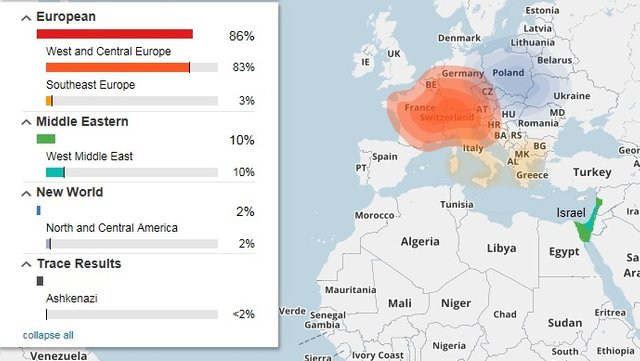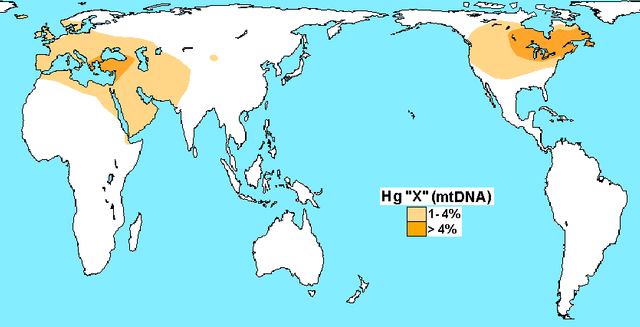My FamilyTreeDNA.com Results : 52% Farmer 34 % Hunter Gatherer and 14 % Metal Age Invader.
A few years ago I ordered the Y-DNA (paternal) and mtDNA (maternal) Test kits from FamilyTreeDNA.com since I wanted to learn more about my ancient ancestors in Italy, France and Canada. As the Database grows FamilyTreeDNA is able to send out more detailed and better information and Origin Maps as new people join the Family DNA Project and help to fill in gaps of the Origins and movement of people across the earth.
Recently they sent me the following Map and breakdown of my Ancient Ancestors Origins ....
It is interesting that the results show that I am only 2% from the New World (Canada) when my maternal DNA Haplogroup is X2a - Ojibwe.
I was also surprised by the 10 % Middle Eastern Results. My Dad's family was from Calabria in Southern Italy possibly via Spain around 1200's, so maybe that's the < 2% Ashkenazi ? I would have guessed Sephardic ...

Maybe the 10 % Middle Eastern Results are linked to my Maternal X Haplogroup that originates around Lake Superior in Canada (X2a Ojibwe) and the Sea of Galilee in Israel (X2) : https://en.wikipedia.org/wiki/Haplogroup_X_(mtDNA)
FARMER 52%
Roughly 8,000–7,000 years ago, after the last glaciation period (Ice Age), modern human farming populations began migrating into the European continent from the Near East. This migration marked the beginning of the Neolithic Era in Europe. The Neolithic Era, or New Stone Age, is aptly named as it followed the Paleolithic Era, or Old Stone Age. Tool makers during the Neolithic Era had improved on the rudimentary “standard” of tools found during the Paleolithic Era and were now creating specialized stone tools that even show evidence of having been polished and reworked. The Neolithic Era is unique in that it is the first era in which modern humans practiced a more sedentary lifestyle as their subsistence strategies relied more on stationary farming and pastoralism, further allowing for the emergence of artisan practices such as pottery making.
Farming communities are believed to have migrated into the European continent via routes along Anatolia, thereby following the temperate weather patterns of the Mediterranean. These farming groups are known to have populated areas that span from modern day Hungary, Germany, and west into Spain. Remains of the unique pottery styles and burial practices from these farming communities are found within these regions and can be attributed, in part, to artisans from the Funnel Beaker and Linear Pottery cultures. Ötzi (the Tyrolean Iceman), the well-preserved natural mummy that was found in the Alps on the Italian/Austrian border and who lived around 3,300 BCE, is even thought to have belonged to a farming culture similar to these. However, there was not enough evidence found with him to accurately suggest to which culture he may have belonged.
Although farming populations were dispersed across the European continent, they all show clear evidence of close genetic relatedness. Evidence suggests that these farming peoples did not yet carry a tolerance for lactose in high frequencies (as the Yamnaya peoples of the later Bronze Age did); however, they did carry a salivary amylase gene, which may have allowed them to break down starches more efficiently than their hunter-gatherer forebears. Further DNA analysis has found that the Y-chromosome haplogroup G2a and mitochondrial haplogroup N1a were frequently found within the European continent during the early Neolithic Era.
HUNTER-GATHERER 34%
The climate during the Pleistocene Epoch (2.6 mill – 11,700 YA) fluctuated between episodes of glaciation (or ice ages) and episodes of warming, during which glaciers would retreat. It is within this epoch that modern humans migrated into the European continent at around 45,000 years ago. These Anatomically Modern Humans (AMH) were organized into bands whose subsistence strategy relied on gathering local resources as well as hunting large herd animals as they travelled along their migration routes. Thus these ancient peoples are referred to as Hunter-Gatherers. The timing of the AMH migration into Europe happens to correspond with a warming trend on the European continent, a time when glaciers retreated and large herd animals expanded into newly available grasslands.
Evidence of hunter-gatherer habitation has been found throughout the European continent from Spain at the La Brana cave to Loschbour, Luxembourg and Motala, Sweden. The individuals found at the Loschbour and Motala sites have mitochondrial U5 or U2 haplogroups, which is typical of Hunter-Gatherers in Europe and Y-chromosome haplogroup I. These findings suggest that these maternally and paternally inherited haplogroups, respectively, were present in the population before farming populations gained dominance in the area.
Based on the DNA evidence gathered from these three sites, scientists are able to identify surviving genetic similarities between current day Northern European populations and the first AMH Hunter-Gatherers in Europe. The signal of genetic sharing between present-day populations and early Hunter-Gatherers, however, begins to become fainter as one moves further south in Europe. The hunter-gatherer subsistence strategy dominated the landscape of the European continent for thousands of years until populations that relied on farming and animal husbandry migrated into the area during the middle to late Neolithic Era around 8,000–7,000 years ago.
METAL AGE INVADER 14%
Following the Neolithic Era (New Stone Age), the Bronze Age (3,000–1,000 BCE) is defined by a further iteration in tool making technology. Improving on the stone tools from the Paleolithic and Neolithic Eras, tool makers of the early Bronze Age relied heavily on the use of copper tools, incorporating other metals such as bronze and tin later in the era. The third major wave of migration into the European continent is comprised of peoples from this Bronze Age; specifically, Nomadic herding cultures from the Eurasian steppes found north of the Black Sea. These migrants were closely related to the people of the Black Sea region known as the Yamnaya.
This migration of Bronze Age nomads into the temperate regions further west changed culture and life on the European continent in a multitude of ways. Not only did the people of the Yamnaya culture bring their domesticated horses, wheeled vehicles, and metal tools; they are also credited for delivering changes to the social and genetic makeup of the region. By 2,800 BCE, evidence of new Bronze Age cultures, such as the Bell Beaker and Corded Ware, were emerging throughout much of Western and Central Europe. In the East around the Urals, a group referred to as the Sintashta emerged, expanding east of the Caspian Sea bringing with them chariots and trained horses around 4,000 years ago.
These new cultures formed through admixture between the local European farming cultures and the newly arrived Yamnaya peoples. Research into the influence the Yamnaya culture had on the European continent has also challenged previously held linguistic theories of the origins of Indo-European language. Previous paradigms argued that the Indo-European languages originated from populations from Anatolia; however, present research into the Yamnaya cultures has caused a paradigm shift and linguists now claim the Indo-European languages are rooted with the Yamnaya peoples.
By the Bronze Age, the Y-chromosome haplogroup R1b was quickly gaining dominance in Western Europe (as we see today) with high frequencies of individuals belonging to the M269 subclade. Ancient DNA evidence supports the hypothesis that the R1b was introduced into mainland Europe by the Bronze Age invaders coming from the Black Sea region. Further DNA evidence suggests that a lactose tolerance originated from the Yamnaya or another closely tied steppe group. Current day populations in Northern Europe typically show a higher frequency of relatedness to Yamnaya populations, as well as earlier populations of Western European Hunter-Gatherer societies."
Source: http://www.FamilyTreeDNA.com
Any surprises for you in the results?
10 % Middle Eastern and only 2% New World when my Maternal DNA is Ojibwe !
Goes to that whole "American Indians are actually a lost tribe of Israel" theory.
Well... interestingly I learned that Haplogroup X2 originates around Lake Superior in Canada (Ojibwe) and around the Sea of Galilee in Israel. Maybe the ancient Israelites or Druze come from Canada.
That would the Reverse World Theory. LOL
Yes, the Ojibwe (Ani-Shin-Abe) are far more ancient .... 22,000 - 30,000 years in Canada, compared to Israeli Creation 5,778 years ago .... https://coffeeshoprabbi.com/2016/09/04/5777-jewish-years-explained/
This sounds like it would be great to learn about family. How safe is this tho to send your dna to them?
I'm hoping that since they have my DNA locked away in a Secure Database that they will be able to clone me some day in the future and I will come back as me for a second go around.
Haha thats one way to look at it... guess you may have a twin
Maybe they have already cloned me.... how would I ever know ?
@minnowpond1 has voted on behalf of @minnowpond. If you would like to recieve upvotes from minnowponds team on all your posts, simply FOLLOW @minnowpond.